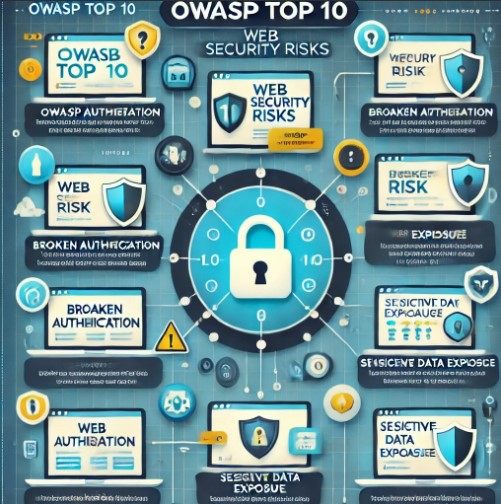Table of Contents
- 1 Introduction
- 2 What is the OWASP Top 10?
- 3 1. Injection
- 4 2. Broken Authentication
- 5 3. Sensitive Data Exposure
- 6 4. XML External Entities (XXE)
- 7 5. Broken Access Control
- 8 6. Security Misconfiguration
- 9 7. Cross-Site Scripting (XSS)
- 10 8. Insecure Deserialization
- 11 9. Using Components with Known Vulnerabilities
- 12 10. Insufficient Logging and Monitoring
- 13 FAQ
- 14 Conclusion
Introduction
In today’s digital world, web applications are crucial for businesses and individuals alike. However, with the growth of online platforms, web security has become a major concern. Hackers often exploit vulnerabilities to gain unauthorized access, disrupt services, or steal sensitive information. To tackle this, the Open Web Application Security Project (OWASP) has created a list of the top 10 web application security risks. This list, known as the OWASP Top 10, serves as a global standard for developers and security professionals to identify and mitigate critical vulnerabilities.
In this article, we’ll dive deep into each OWASP Top 10 vulnerability, offering basic to advanced examples, prevention techniques, and best practices. Let’s explore how understanding and addressing these risks can safeguard your web applications.
What is the OWASP Top 10?
The OWASP Top 10 is a periodically updated list of the most critical security risks for web applications. It aims to guide developers and security experts on common vulnerabilities, enabling them to create safer applications. Let’s break down each risk and provide practical insights for mitigating them.
1. Injection
What is Injection?
Injection flaws occur when untrusted data is sent to an interpreter as part of a command or query, allowing attackers to execute unintended commands or access data without authorization. SQL injection is the most common example.
Example of Injection
Consider an SQL query like:
SELECT * FROM users WHERE username = 'admin' AND password = '';An attacker could manipulate this query by injecting SQL code, bypassing authentication.
Prevention Tips
- Use Parameterized Queries: Always sanitize and validate inputs.
- Use ORM (Object Relational Mapping): ORM frameworks can mitigate SQL injection by generating safe queries.
- Apply Least Privilege Principle: Limit database permissions to reduce potential damage.
For more details on SQL injection, visit the OWASP SQL Injection Guide.
2. Broken Authentication
What is Broken Authentication?
Broken authentication refers to vulnerabilities that allow attackers to bypass authentication mechanisms and impersonate other users.
Example of Broken Authentication
A common example is using weak passwords or not implementing multi-factor authentication (MFA).
Prevention Tips
- Use Strong Password Policies: Enforce complex passwords.
- Implement Multi-Factor Authentication (MFA): This adds an extra layer of security.
- Limit Failed Login Attempts: This deters brute force attacks.
3. Sensitive Data Exposure
What is Sensitive Data Exposure?
Sensitive data exposure happens when applications improperly protect sensitive information, such as credit card numbers or social security numbers.
Example of Sensitive Data Exposure
Storing passwords without encryption is a major vulnerability. If breached, attackers gain easy access to user accounts.
Prevention Tips
- Encrypt Sensitive Data: Use strong encryption like AES-256.
- Use HTTPS: Encrypts data transmitted over the network.
- Minimize Data Storage: Only store necessary information.
For more on HTTPS security, refer to Google’s HTTPS Overview.
4. XML External Entities (XXE)
What is XML External Entities?
XXE vulnerabilities happen when XML processors interpret external entities within XML documents, potentially exposing sensitive data or enabling a denial-of-service attack.
Example of XXE
An XML parser might inadvertently open network connections based on the attacker’s XML payload, potentially leaking data.
Prevention Tips
- Disable External Entity Processing: Configure parsers to reject external entities.
- Use JSON instead of XML: JSON doesn’t support external entities, reducing the attack surface.
- Regularly Update XML Libraries: Vulnerabilities in libraries are often patched.
5. Broken Access Control
What is Broken Access Control?
Broken access control occurs when unauthorized users can access restricted areas or information in an application.
Example of Broken Access Control
An attacker might gain access to admin functions simply by changing URL parameters.
Prevention Tips
- Implement Role-Based Access Control (RBAC): Limit access based on user roles.
- Verify Access Controls Continuously: Ensure all endpoints and actions require proper authorization.
- Use Server-Side Validation: Never rely solely on client-side controls.
For more on access control, see OWASP’s Guide on Access Control.
6. Security Misconfiguration
What is Security Misconfiguration?
Security misconfigurations are weaknesses that arise from poorly defined security settings, such as leaving default passwords or revealing error messages with sensitive information.
Example of Security Misconfiguration
Leaving the default admin password on a CMS can allow attackers easy access to admin panels.
Prevention Tips
- Use Automated Security Scans: Regularly scan for misconfigurations.
- Disable Unnecessary Features: Minimize application footprint by disabling unnecessary services.
- Apply Secure Defaults: Change default passwords and configurations immediately.
7. Cross-Site Scripting (XSS)
What is Cross-Site Scripting?
XSS vulnerabilities occur when attackers inject malicious scripts into trusted websites, often to steal user information.
Example of XSS
An attacker might insert a script in a user comment section, which executes in other users’ browsers, collecting session tokens.
Prevention Tips
- Validate and Sanitize Inputs: Block HTML tags and other scripts from user inputs.
- Implement Content Security Policy (CSP): Restricts the sources from which resources like scripts can be loaded.
- Use Escaping Libraries: Libraries like
OWASP Java EncoderorESAPIhelp prevent XSS by escaping untrusted data.
8. Insecure Deserialization
What is Insecure Deserialization?
Insecure deserialization happens when untrusted data is used to recreate application objects, allowing attackers to manipulate serialized objects.
Example of Insecure Deserialization
Using serialized user data in cookies can be risky if attackers modify it to change roles or permissions.
Prevention Tips
- Avoid Deserializing Untrusted Data: Only deserialize data from known sources.
- Use Serialization Safely: Use libraries that validate input.
- Implement Integrity Checks: Use digital signatures to verify serialized data authenticity.
9. Using Components with Known Vulnerabilities
What is Using Components with Known Vulnerabilities?
Using outdated libraries or frameworks can introduce known security risks into your application.
Example of Using Vulnerable Components
A common example is using an outdated version of a popular framework with known exploits.
Prevention Tips
- Keep Libraries Up-to-Date: Regularly update dependencies to the latest versions.
- Automate Dependency Management: Tools like Dependabot and Snyk help track and manage dependencies.
- Use Trusted Sources: Download libraries only from reputable sources.
For a list of known vulnerabilities, refer to the NIST Vulnerability Database.
10. Insufficient Logging and Monitoring
What is Insufficient Logging and Monitoring?
When security incidents occur, insufficient logging and monitoring can delay detection and response, increasing the damage.
Example of Insufficient Logging and Monitoring
If an application doesn’t log failed login attempts, a brute-force attack might go unnoticed.
Prevention Tips
- Enable Detailed Logging: Log critical events, including failed authentication attempts.
- Regularly Review Logs: Implement real-time monitoring and review logs frequently.
- Establish Incident Response Protocols: Have a plan in place for responding to suspicious activity.
FAQ
What is OWASP?
OWASP (Open Web Application Security Project) is a global non-profit organization focused on improving software security.
Why is the OWASP Top 10 important?
The OWASP Top 10 highlights the most critical security risks, helping developers and security professionals prioritize their security efforts.
How often is the OWASP Top 10 updated?
The list is updated every few years to reflect the evolving security landscape. The last update was released in 2021.
Where can I learn more about securing web applications?
OWASP provides numerous resources, including OWASP Cheat Sheets and the OWASP Foundation.

Conclusion
Understanding and mitigating the OWASP Top 10 security risks is essential for creating secure web applications. By addressing these common vulnerabilities, you can protect your users and maintain the integrity of your web applications. For additional information and resources, consider exploring the full OWASP Top 10 Project. Remember, web security is an ongoing process-regular updates, audits, and best practices are key to maintaining secure applications. Thank you for reading the DevopsRoles page!
